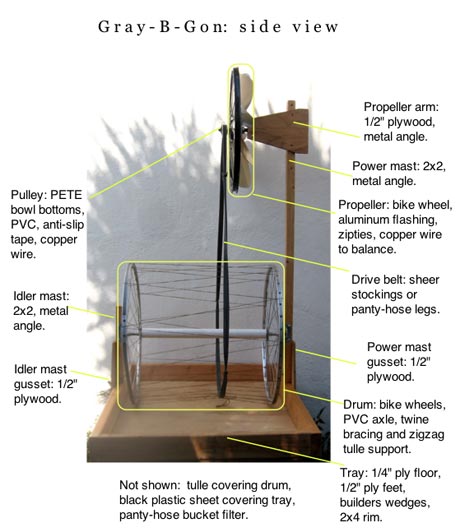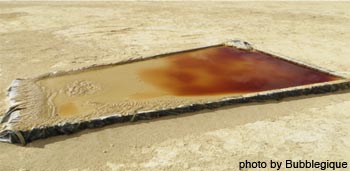What is Greywater?
Greywater is water that has been used for cooking, washing, dishwashing, or bathing and contains soap, detergent, food scraps, or food residue.
Why is it a problem?
It’s hard to make it disappear. Almost anywhere else in the world, a campsite is near absorbent soil (filled with microbial activity, and usually with plants) where it is safe and decent to dump greywater. But it’s different on the playa, on dried clay, striving to avoid contaminating our surroundings.
Don’t dump it!
Dumping large amounts of untreated water on the playa introduces contaminants and can turn the clay into instant slippery, sticky mud. This can make walking nasty for your neighbors, and violates Burning Man’s contract with our landlord, the Bureau of Land Management. You could get a citation and a fine.
Don’t put it in the Potty!
Each potty serves 40 to 50 people, and can handle only pee, poop, and special toilet paper — absolutely nothing else. Toilets are for black water, not greywater.
Grey Water Disposal Options
There are several acceptable ways to dispose of grey water. Pick one that works for you.
-
Have USS empty your RV tanks on-playa.
- You can flag down a USS truck, one that isn’t busy servicing potties, and ask them to send a pumper to your RV location. It’ll cost you $60 or more.
-
Pack it out.
- You can accumulate your greywater and pack it out when you leave, perhaps reusing your resealable freshwater containers.
- Caution: once you put greywater in them, your containers should never be used for anything else. Watch out for single-use containers that require you to stab an air-hole in them; they would leak graywater during the return trip. You’ll need to have a funnel and bottles which are both re-fillable and disposable, so plan ahead. While you store your greywater, you’ll need to keep it chlorinated (explained below). Take it all the way home, or to a dumping station along the way.
-
Haul to RV Dump Station.
- Several RV parks and truck stops are listed below. Dumping tanks costs around 5-10 dollars.
-
Install an evapotron in your camp.
- Evapotrons are Burner-built devices for evaporating greywater in the playa’s intensely dry air. The Pumped Cascade design is powered by sunlight on a solar cell; the Gray-B-Gon is powered by a small windmill. Either design can meet the disposal needs of ten or more people.
-
Share an evapotron.
- Camps with evapotrons usually have excess capacity, and often will help neighbors dispose of greywater. Ask first, of course.
- DO NOT USE evaporation ponds (yesterday’s technology). Evaporation ponds — black plastic sheeting laid on the playa, over a rim of two-by-fours on edge — were the earliest evaporative devices invented for the Playa, but we cannot recommend them. Ponds take an enormous amount of space to make a shallow layer of water, they’re hard to make perfectly level, and they eventually fill with mud. Pond evaporative performance relies on a sunlight-absorbing black surface, and playa dust gradually disables it. Then you have to pump out the pond, and clean or reline it. **Your pond may attract slip-and-slide buckaroos, whose antics can tear up the plastic surface. Many other mishaps can cause pinhole leaks, which eventually make large muddy patches on the Playa. Even if it never leaks, it will probably spill when you try to empty it. At the end of the event, you have a very nasty mess of stuff to take home in your vehicle. And it didn’t even get rid of that much grey water.
-
Be a sanitation expert.
- A very few Burners are experts in water sanitation, and in past years have brought and used professional-level water-purification systems; yesterday’s shower becomes today’s fresh coffee.
- If you are an expert, you know it. But beware trying out an advanced technology if you’re not an experienced professional. More than one camp has discovered that (for example) their flocculation tank pH was off, so they had no grey water disposal at all.


-
Dump station.
Remember these tips from www.rvdumps.com when emptying your greywater holding tanks:
- Use a heavy-duty sewer hose about 6 to 8 feet long to make handling easier.
- Carry an extra garden hose for rinsing in case the dump station doesn’t have one. Store this in an area where it won’t come into contact with your drinking water hose.
- Never use your fresh water hose for rinsing sewer hoses or the dump station area.
- Wear protective rubber gloves and avoid touching the outside of the gloves.
- If others are waiting to use the dump station, skip the tank flushing and hose rinsing steps. Pull away from the dump station and then add some water and chemicals to the holding tanks.
- Never put anything other than the contents of your holding tanks into the dump station.
- Leave the dump station area cleaner than you found it.
Dump Station Abuse
(also from www.rvdumps.com)
For years RVers have been pulling into Interstate rest areas and other areas with free dump stations to empty their holding tanks. But because of abuse, many states are removing dump stations from their rest areas, and campground owners and others view their dump stations as an expensive maintenance headache due to abuse of the facilities. Dump station abuse amounts to folks leaving a mess or putting things into the dump drain that just don’t belong there. Remember: somebody has to clean up the mess or clean out the drain. Dump station abuse causes aggravation, creates a health hazard, and costs money. You can do your part to ensure RVers and campers will continue to have free and clean dump stations by following the simple tips mentioned above.
Frequently Asked Questions
- How dangerous is greywater? What can I do about it?
- Greywater is inherently unsanitary. It may contain bacteria, fungi, viruses, or other life. Greywater left to stand untreated in the desert warmth eventually becomes black water as microbial populations increase.
- To disinfect greywater, and suppress funky aromas, mix in Concentrated Clorox Regular Bleach or other chlorine-based bleach periodically. For some antibiotic-resistant pathogens, chlorine bleach is the only reliable killer. The active ingredient in chlorine bleach is sodium hypochlorite, a powerful disinfectant that decomposes into water and salt. Age, sunlight, warmth, and greywater impurities (including playa dust) all increase the rate of decomposition, soon exhausting the disinfecting power. Make sure your bleach is newly purchased, not left over from last year.
- How much bleach do I need to disinfect?
- The following rule will help compensate for all these uncertainties.
- Use the No-Measure Rule of Thumb for Disinfecting:
- Follow Your Nose.
- Loosen the cap of your bleach jug one-half turn: no farther, or it may come off.
- Using your thumb to restrain the cap, tip the jug over your greywater and dribble for about two seconds per gallon.
- Slosh or stir to mix, and half an hour later, sniff. If it doesn’t have a strong chlorine tang (like a public swimming pool) dribble in more bleach and check it again later.
- Make this a morning and evening habit.
- When buying chlorine bleach, check the label for the concentration of sodium hypochlorite. Concentrated Clorox Regular Bleach has about 9%. If another brand has 6%, it should cost two-thirds as much and you’ll need to add 1.5 times as much. Scented products are always lower in hypochlorite. Bleach has a limited shelf life, and this year’s leftover jug won’t last until next year.
- Disclaimer: We are not sanitation experts, but an expert at Clorox Corp reviewed this text. Following the guidelines above is not guaranteed to fully disinfect your water.
- How can I reduce my greywater?
- The easiest greywater to dispose of is the greywater you don’t produce.
- If you bring less water, you will use less. But bring at least 1.5 gallon per day per person, mostly for drinking.
- Use waterless disinfectant lotion (available at drugstores) to sanitize your hands before you handle food.
- For dish or bath soap, go ecofriendly with Campsuds.
- For general cleaning, try Dr. Bronner’s Sal Suds.
- In your kitchen area, set up a low-volume water spray over a basin, for dishwashing and hand cleaning.
- A personal spray bottle, like the Cool Blast, is a good starting point.
- Bring several small hand towels (say three per person); use one towel end on clean dishes and the other end to wipe your hands and face clean. You’ll need remarkably little water to wash up with.
- Wipe out dishes with paper towels rather than washing, or before washing.
- Save a dish. Eat from the cookpot. Lick out the cookpot, or scrape and rinse it with clean water, then think “This soup is thin but wholesome” and drink it.
- Save up your cooler’s ice-melt water to refill your solar shower bag. When you shower, first get wet and turn the water off; then soap up and scrub down, then turn the water back on to rinse off. Or shower with a friend, and trade off controlling and directing the water supply.
- Hard core: take a sponge bath instead. It’s possible to wash your body clean with a pint of water, soap and a washrag.

